
Con-Cor Pioneer Zephyr

As much as I love the big steamers like the Big Boy or Y6B, I love the vintage streamliners like the Dreyfuss Hudson or GS4 in Southern Pacific’s Daylight colors. This Pioneer Zephyr truly symbolizes the golden age of passenger train travel.
The Zephyr was a diesel powered locomotive that entered service in late 1934. Earlier that year, the Zephyr set a speed record for travel between Denver and Chicago at an average speed of 77mph. It’s max speed hit 112.5mph, just shy of the land speed record held at the time of 115mph.


Con-Cor’s HO version of the Zephyr is a plastic model that comes DCC ready. The train is sold as a three-piece set that includes the loco, baggage car and observation lounge. One can also purchase individual coaches to add to the consist.

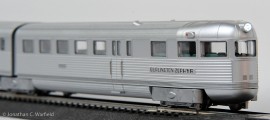
The detail is decent on the Con-Cor Zephyr. Not as detailed as the brass versions I’ve seen, but considering the price differential, that’s expected. The locomotive has a good amount of weight added to it, but the cars are very light and could probably use some added weight to help them handle the occasional uneven track. I won’t add weight until I see it pulling my entire consist that includes three add-on coaches.
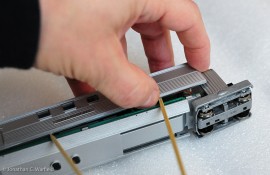
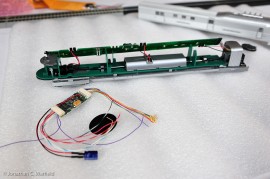
Adding a decoder is fairly simple. Adding a sound decoder gets a little more complicated. Whatever decoder you decide to install, it must go inside the locomotive. The first step is to remove the locomotive shell. It’s only snapped on, so you can pry it off fairly easily, working from the body’s overhang at the rear. I use a few wooden baking skewers to assist in removing the shell. Once the shell is off, there is ample room for the decoder. The top circuit board has a 10-pin DCC plug, in which an 8-pin decoder plug fits just fine. Just make sure that pin 1 of the plug and socket line up. I didn’t realize the socket was 10 pins and accidentally plugged the decoder in offset by a row of two sockets, so pin 1 was actually in socket 2. Took me a minute and then a palm to the head to realize what I had done when I puzzled over why the loco wouldn’t run.
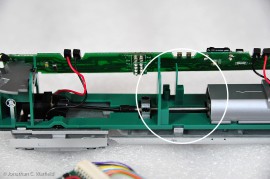
There was a bit of internal “body work” to be done in order to accommodate the decoder’s 1-inch speaker. The supports within the circle, and a good deal of the green plastic “floor” had to be removed in order to give the speaker a clear shot of the pre-drilled speaker “grille” in the bottom of the loco chassis. I would have been able to fit a smaller speaker under the green floor into the shallow alcove provided, but I’m not crazy about the sound coming from a sub-1 inch speaker.
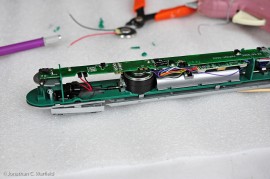
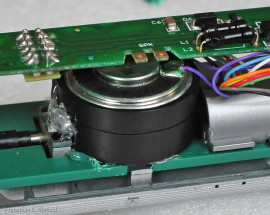
Using nippers and a Dremel, I cut the supports, ground the remains flat, then opened up a good sized hole in the floor to give the speaker a clear shot. I also used the speaker enclosure to help amplify the sound a bit. The enclosure had to be nipped and ground too in order to make room for the drive shaft and bearing assembly. After all the cutting and grinding, I used compressed air to blow the plastic shavings out of the chassis. Then a little hot glue gun action to set the speaker in place.
Here’s some footage of the Zephyr running on our club layout, including some track-level “pace-car” footage.
Here’s the older, original test footage. I got the QSI Revolution decoder from Tony’s Train Exchange, loaded with the correct sounds for the Zephyr. I’ll have to take their word for it, because I’ve never heard or seen a real Zephyr run.
[wordbay]pioneer zephyr[/wordbay]
Originally posted 2015-05-18 12:44:25.
You may also like
Archives
- January 2026
- December 2025
- November 2025
- October 2025
- September 2025
- August 2025
- July 2025
- June 2025
- May 2025
- April 2025
- March 2025
- February 2025
- January 2025
- December 2024
- November 2024
- October 2024
- September 2024
- August 2024
- June 2024
- May 2024
- March 2024
- January 2024
- November 2023
- October 2023
- September 2023
- August 2023
- September 2013
- August 2013
- March 2013
- September 2012
- June 2012
- December 2011
- August 2011
- July 2011
- May 2011
- March 2011
- January 2011
- December 2010
- November 2010
- September 2010
- August 2010
- July 2010
- June 2010
- April 2010
- March 2010
- February 2010
- January 2010
- December 2009
- November 2009
- October 2009
- September 2009
- August 2009
- July 2009
- June 2009
- May 2009
- April 2009
- March 2009
- February 2009
- January 2009
- December 2008
- November 2008
- October 2008
- September 2008
- August 2008
- July 2008
- June 2008
- May 2008
- April 2008
- March 2008
- February 2008
- January 2008
- December 2007
- November 2007
- October 2007
- September 2007
Leave a Reply